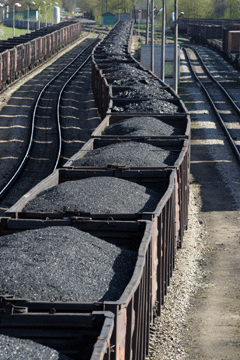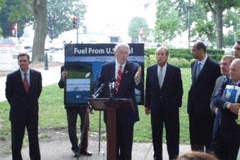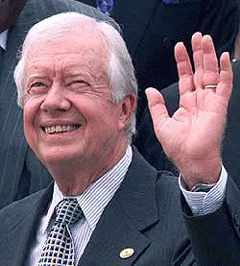Fill ‘er up—with coal?
Air Date: Week of April 27, 2007

(Courtesy of the State of Indiana)
Some powerful members of Congress say a liquid form of coal is the cure for America’s oil addiction. But there are serious environmental concerns. Living on Earth’s Jeff Young looks at the curious history and possible future of liquid coal.
Transcript
YOUNG: From the Jennifer and Ted Stanley Studios in Somerville, Massachusetts - this is Living on Earth. I’m Jeff Young, sitting in for Steve Curwood. The world runs on oil. But as supplies drop and concern about climate change grows, the search is on for alternative fuels. We’ll take a close look at two possible substitutes. In a few minutes, we’ll hear about the promise and pitfalls of some biofuels.
But first, how about filling up your tank with coal? That’s right, that hard rock can also be turned into a liquid fuel for transportation. The U.S. has enough coal to last 200 years or more. A lot of people on Capitol Hill think it could replace oil. And liquid coal is also getting a lift from the U.S. Air Force.
ANDERSON: Energy for us is a national security issue. We need energy to do the job that the American people pay us to do- that is fly and fight.
YOUNG: That’s Air Force assistant secretary William Anderson. He says the Air Force burns through some two and a half billion gallons of aviation fuel in a year. A recent test proved a B-52 bomber could fly on liquid coal.
ANDERSON: This looks like the best viable non-oil option for us.

This B-52, shown here at Edwards Air Force Base, uses a blend of synthetic fuel in all eight engines. (Photo: Jet Fabara/Air Force Material Command)
BUNNING: In spite of what everybody says, if they’d do their homework and their scientific background checks, they will find it burns significantly cleaner than any other synthetic fuel.
YOUNG: Indeed, compared to gasoline, liquid coal puts out less sulfur, nitrogen and particulate matter. But it does produce a lot of the greenhouse gas carbon dioxide. Phil Clapp at the advocacy group National Environmental Trust says that makes it a bad choice for the climate.
CLAPP: The average gallon of a liquefied coal fuel will generate twice as much carbon dioxide, twice as much global warming pollution, as a gallon of gasoline.
YOUNG: Supporters say they could capture the extra carbon from coal as the liquid is produced. That yields a fuel with tailpipe greenhouse gas emissions about the same as gasoline. But Clapp doubts that would happen.
CLAPP: The reality is we haven’t demonstrated that on a mass scale so it can even be used on electric power plants yet. And that’s one reason for the phenomenal eight billion dollar price tag on every plant.

Senator Jim Bunning discusses moving the 'Coal-To-Liquid Fuel Promotion Act of 2006' forward at a liquid coal press conference. (Courtesy of U.S. House of Representatives)
WARD: Everybody wants to be the first person to build the fifth plant.
YOUNG: That’s John Ward, he’s with an energy development company called Headwaters Energy. Ward’s been making the rounds in Washington pitching liquid coal to lawmakers. He can also tell the fuel’s curious history. It starts with two German scientists early in the 20th century.
WARD: This is kind of the Saturday Night Live joke: it’s Hans and Franz-- they were behind the first development of a catalyst.
YOUNG: Hans and Franz Fuel would have had a pretty nice ring to it. Unfortunately, the catalyst they invented went by their last names—Fischer and Tropsch. It turned coal into a liquid that could be refined into gasoline, diesel or aviation fuel. And Germany found a use for that in the 1940s.
[GERMAN NEWS REAL OF TANKS AND PATRIOTIC MUSIC]
YOUNG: World War 2 allied forces cut Germany’s oil supply. So Nazis kept their war machine running on liquid coal. After the war the fuel fell out of favor except in South Africa. South Africa had lots of coal, very little oil, and reason to worry that it could be cut off from the world’s petroleum trade.
BOTHA: Destroy white South Africa and this country will drift in faction strife, chaos, and poverty.
YOUNG: That was P.W. Botha, one of the last and most defiant leaders of South Africa’s apartheid government. Facing an international trade embargo South Africa invested heavily in coal to liquid refineries. Long after apartheid rule passed, South Africa’s energy company Sassol remains a world leader. John Ward says the industry takes root in countries with a strong interest in developing domestic fuels.
WARD: In both Germany and South Africa it was because they lost access to liquid fuels from other parts of the world and that’s exactly the same situation that faces the U.S. today. People are interested in doing coal to liquids here because we’re tired of sending trillions of dollars to countries who don’t particularly like us and be able to seize the initiative and create an industry that uses an American resource and creates American jobs to provide a more dependable source of liquid fuels.
YOUNG: The U.S. has been down this road before. If you remember bell-bottoms and disco, you probably also remember this.

Former U.S. President Jimmy Carter. (Courtesy of U.S. Embassy- Uruguay)
CARTER: Good evening, tonight I want to have an unpleasant talk with you, about a problem that’s unprecedented in our history. With the exception of preventing war, this is the greatest challenge that our country will face during our lifetime. The energy crisis is not yet on the front of the list, but it will be if we do not act quickly.
YOUNG: During the energy crisis of the 1970’s President Jimmy Carter pumped billions into liquid coal.
CARTER: We can protect ourselves from uncertain supplies by reducing our demand for oil, by making the most of our abundant resources such as coal.
YOUNG: A few demonstration projects were built, but the country ended up with little to show for its money. When the oil rich nations of OPEC let more oil flow, prices dropped and industry lost interest in oil alternatives. So what should we learn from this liquid coal history? Industry booster John Ward says it teaches us that we need to support alternative fuels against market manipulation by the oil cartels.
WARD: That’s an appropriate national security role for the federal government to step in and provide conditions that allow this industry to get started on a fair footing.

Coal train (Courtesy of the State of Indiana)
YOUNG: But Phil Clapp of the National Environmental Trust sees a different lesson.
CLAPP: This is the resurrection of Jimmy Carter’s ill-fated synthetic fuels program- all you ended up with was kind of a taxpayer rip-off. This is not something that’s ever survived in the marketplace and it’s only governments dumping big amounts of money into it.
YOUNG: Some in Congress share Clapp’s concerns about cost and climate. They also worry that liquid coal would undercut other alternative fuels like ethanol from cellulose. But the White House included liquid coal in a recent proposal on alternative fuels. And supporters like New Mexico’s Republican Senator Pete Domenici are confident it will get help from Washington.
DOMENCI: Coal to liquids will happen. I don’t think you can stop it. For those who are opposed to it they better get their shields up.
YOUNG: Whatever the U.S. does it looks like liquid coal is expanding elsewhere. China is building new facilities in its coal producing regions.
[MUSIC: Jenny Wilson “Would I Play With My Band” from ‘Love & Youth’ (Rabid Records – 2006)]
Links
Living on Earth wants to hear from you!
Living on Earth
62 Calef Highway, Suite 212
Lee, NH 03861
Telephone: 617-287-4121
E-mail: comments@loe.org
Newsletter [Click here]
Donate to Living on Earth!
Living on Earth is an independent media program and relies entirely on contributions from listeners and institutions supporting public service. Please donate now to preserve an independent environmental voice.
NewsletterLiving on Earth offers a weekly delivery of the show's rundown to your mailbox. Sign up for our newsletter today!
 Sailors For The Sea: Be the change you want to sea.
Sailors For The Sea: Be the change you want to sea.
 The Grantham Foundation for the Protection of the Environment: Committed to protecting and improving the health of the global environment.
The Grantham Foundation for the Protection of the Environment: Committed to protecting and improving the health of the global environment.
 Contribute to Living on Earth and receive, as our gift to you, an archival print of one of Mark Seth Lender's extraordinary wildlife photographs. Follow the link to see Mark's current collection of photographs.
Contribute to Living on Earth and receive, as our gift to you, an archival print of one of Mark Seth Lender's extraordinary wildlife photographs. Follow the link to see Mark's current collection of photographs.
 Buy a signed copy of Mark Seth Lender's book Smeagull the Seagull & support Living on Earth
Buy a signed copy of Mark Seth Lender's book Smeagull the Seagull & support Living on Earth

